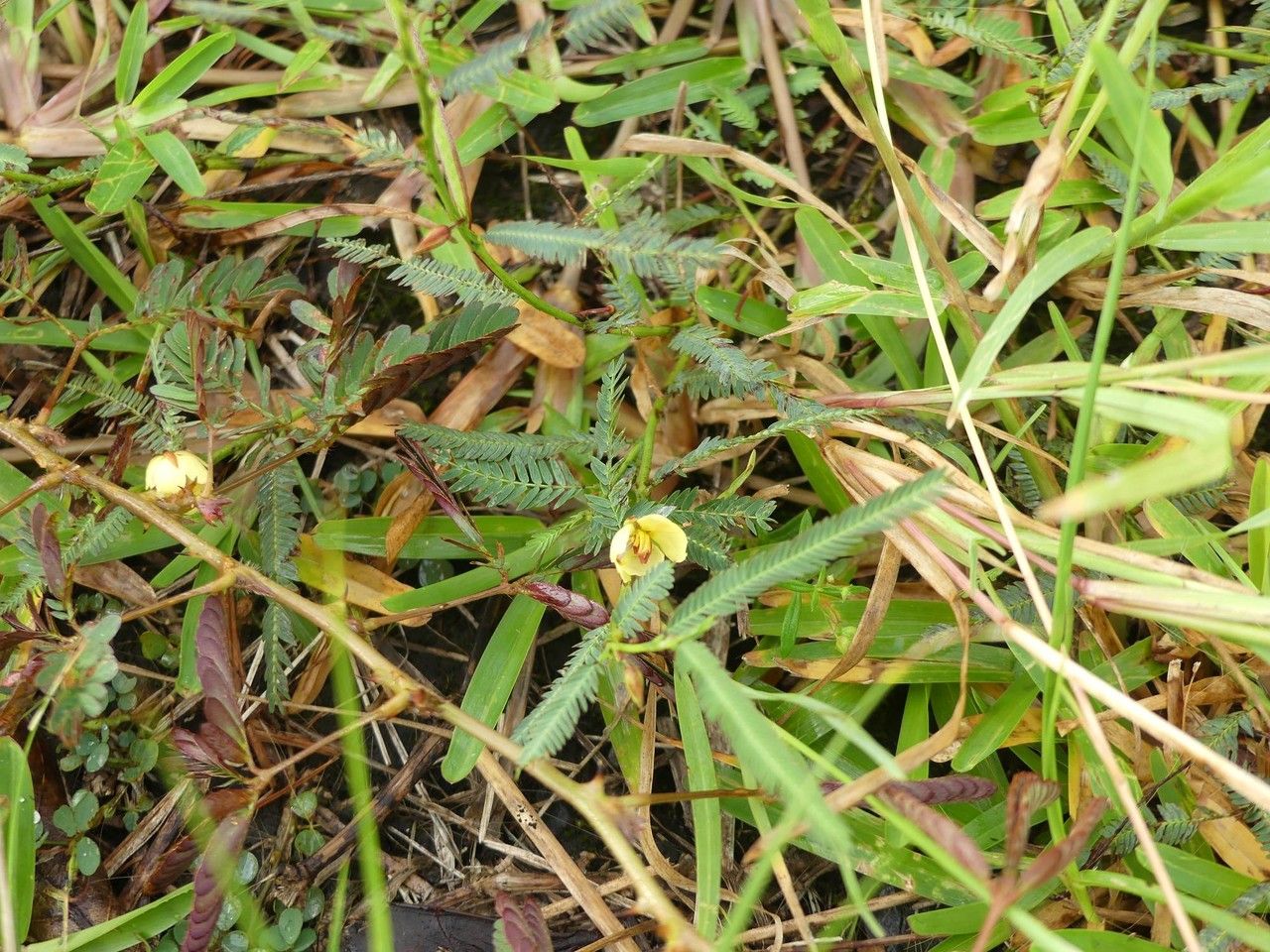Sensitive Plant
chamaecrista nictitans
Also known as: ["Mimosa nictitans","Shrubby Sensitive Plant"]
Overview
A small, deciduous shrub known for its sensitive leaves that fold inward when touched or exposed to darkness.
Benefits & Perks
["wildlife attractant (bees, butterflies, birds)","seasonal color change"]
Botanical Classification
| Phylum: | Magnoliophyta |
| Class: | Magnoliopsida |
| Order: | Fabales |
| Family: | Fabaceae |
| Genus: | Chamaecrista |
| Botanical Name: | Chamaecrista nictitans |
Plant Characteristics
Basic Information
- Category: Shrubs
- Suitable Location: outdoor garden bed in temperate to subtropical regions, or as a container plant in cooler climates
- Suitable For:
- Is Weed: No
- Allergenicity: low
Environmental Needs
- Climate: {"temperatureRange":"10–35°C"}
- Hardiness: {"zones":"8–11"}
- Misting: rarely required, only if ambient humidity is very low
- Drainage: Fast-draining to prevent root rot.
- Soil Type: Well-draining, slightly acidic mix like cactus soil with added organic matter.
Maintenance Level
- Maintenance Level: moderate
- Toughness Level: moderate
- Pruning Frequency: Light pruning every 2–3 months; major pruning annually after flowering.
- Pruning Intensity: Moderate; remove up to one-third of growth if needed.
Care Details
Ideal Sunlight Coverage:
Bright indirect light for 6–8 hours daily; can tolerate some direct morning sun but avoid harsh afternoon sun.
Sunlight Tolerance Tips:
Acclimate gradually to direct light; protect from intense midday sun; adjust placement based on indoor/outdoor conditions.
Care Requirements
Care Difficulty
moderatemoderate
Sunlight
full sun to partial shade
Rotate plant weekly; use sheer curtains for filtered light; avoid direct afternoon sun.
Watering
every 7–10 days during active growth, reduce in winter
Water deeply but infrequently; ensure proper drainage; avoid wetting foliage.
Soil
well-drained, sandy loam with moderate organic content
pH: 5.5–6.5 (slightly acidic).
Ensure pots have drainage holes; avoid heavy clay soils; test pH periodically.
Temperature
Prefers 65–80°F (18–27°C); tolerates mild fluctuations but avoid extremes.
Avoid drafts; maintain stable temps; protect from sudden changes.
Fertilizing
every 4–6 weeks during growing season, none in winter
Fertilize only when actively growing; flush soil occasionally to prevent salt buildup; avoid overfertilizing.
Propagation
Methods
Stem cuttings in spring/summer.
Step-by-Step Propagation Guide
- Take cutting.
- Apply hormone.
- Plant in medium.
- Maintain humidity.
- Wait for roots.
Best Time: Spring or early summer when growth is active.
Environment
High humidity, warm (70–75°F), indirect light.
Medium
Well-draining mix like perlite and peat moss.
Hormone
Recommended to promote root growth.
Timeline
Roots in 3–6 weeks; establish in 2–3 months.
Tools Needed
Pruners, rooting hormone, small pots, misting spray bottle.
Quick Tips
Use healthy, non-flowering stems; keep consistently moist; provide bottom heat if possible.
Pruning & Repotting
Pruning Guide
Method
Pinch back tips; cut just above a leaf node; thin out crowded areas.
Pruning Plan
Remove dead or leggy growth to encourage bushiness; shape as needed.
Tools
Clean pruners or scissors, disinfectant.
Checklist
Sanitize tools; prune dead/damaged growth; shape plant; clean up debris.
Repotting Guide
Best Season
Spring, before new growth begins.
Pot Size
One size larger pot; ensure it’s not too big.
Method
Remove plant gently; trim roots if needed; use fresh soil; ensure drainage.
Suggestions
Repot every 2–3 years or when roots fill the pot; beneficial for growth.
Checklist
Check root bound status; prepare new pot; use fresh soil; water after repotting.
Advanced Care Tips
Watering Mastery
Watering Checklist
Check soil moisture; water thoroughly; ensure drainage; adjust for season.
How to Apply Water Properly
Water directly at the root zone until water drains from the bottom; allow excess to drain completely; water in the morning to reduce evaporation.
Watering Schedule Tips
Water thoroughly when the top inch of soil feels dry; reduce frequency in winter to prevent root rot.
Soil Improvement
Add perlite or sand for drainage; incorporate compost for fertility.
Temperature Stress Management
Signs of Temperature Issues
Wilting, leaf drop, or yellowing leaves; stunted growth in cold; scorching in heat.
Cold Stress
Slows growth; may cause leaf drop or dormancy; roots become susceptible to rot.
Solution: Move to a warmer location; insulate pots; avoid overwatering in cold.
Hot Stress
Leaf scorch, wilting, or dehydration; may drop buds or flowers.
Solution: Provide shade; increase humidity; water more frequently but avoid waterlogging.
Fertilizing Guide
Fertilizing Checklist
Check growth phase; dilute fertilizer; apply to moist soil; stop in dormant season.
Fertilizing Method
Use balanced liquid fertilizer diluted to half strength every 4–6 weeks during growing season (spring/summer); cease in fall/winter.
Common Problems & Solutions
Toxicity Warning
Cats
Slightly ToxicCats may experience mild gastrointestinal symptoms if they consume the seeds of Chamaecrista nictitans. The lectins and other compounds in the seeds can cause irritation to the digestive tract.
⚠️ Symptoms:
🌿 Toxic Parts:
⚡ Toxic If:
if eaten
Dogs
Slightly ToxicIn dogs, ingestion of Chamaecrista nictitans seeds can lead to mild gastrointestinal upset due to the presence of lectins and other irritants. While not highly toxic, consumption should be avoided to prevent discomfort.
⚠️ Symptoms:
🌿 Toxic Parts:
⚡ Toxic If:
if eaten
Humans
Slightly ToxicChamaecrista nictitans, commonly known as sensitive plant, contains compounds that can cause mild gastrointestinal distress if ingested. The seeds are the primary toxic parts, containing lectins and other bioactive compounds that may disrupt digestive processes.
⚠️ Symptoms:
🌿 Toxic Parts:
⚡ Toxic If:
if eaten
Frequently Asked Questions
Q: Why do the leaves fold when touched?
A: The leaves exhibit nyctinasty, a response to touch or darkness, likely as a defense mechanism.
Q: Is this plant suitable for indoor cultivation?
A: It is primarily an outdoor plant, but can be grown indoors with sufficient light and space.
Q: Does it require special care?
A: It thrives in well-drained soil and full sun, but may need protection from frost in colder climates.
Quick Reference
| Family: | Fabaceae |
| Care: | moderate |
| Light: | full sun to partial shade |
| Water: | every 7–10 days during activ |
Get Expert Care Tips
Download the Plantious app for personalized care reminders and plant identification!
Google Play App Store








